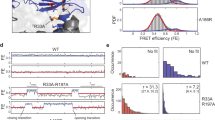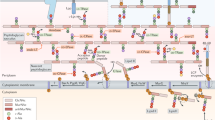Abstract
Multi-protein complexes organized by cytoskeletal proteins are essential for cell wall biogenesis in most bacteria. Current models of the wall assembly mechanism assume that class A penicillin-binding proteins (aPBPs), the targets of penicillin-like drugs, function as the primary cell wall polymerases within these machineries. Here, we use an in vivo cell wall polymerase assay in Escherichia coli combined with measurements of the localization dynamics of synthesis proteins to investigate this hypothesis. We find that aPBP activity is not necessary for glycan polymerization by the cell elongation machinery, as is commonly believed. Instead, our results indicate that cell wall synthesis is mediated by two distinct polymerase systems, shape, elongation, division, sporulation (SEDS)-family proteins working within the cytoskeletal machines and aPBP enzymes functioning outside these complexes. These findings thus necessitate a fundamental change in our conception of the cell wall assembly process in bacteria.
This is a preview of subscription content, access via your institution
Access options
Subscribe to this journal
Receive 12 digital issues and online access to articles
$119.00 per year
only $9.92 per issue
Buy this article
- Purchase on Springer Link
- Instant access to full article PDF
Prices may be subject to local taxes which are calculated during checkout




Similar content being viewed by others
References
Typas, A., Banzhaf, M., Gross, C. A. & Vollmer, W. From the regulation of peptidoglycan synthesis to bacterial growth and morphology. Nat. Rev. Microbiol. 10, 123–136 (2012).
McKenna, M. Antibiotic resistance: the last resort. Nature 499, 394–396 (2013).
Jones, L. J., Carballido-López, R. & Errington, J. Control of cell shape in bacteria: helical, actin-like filaments in Bacillus subtilis. Cell 104, 913–922 (2001).
Garner, E. C. et al. Coupled, circumferential motions of the cell wall synthesis machinery and MreB filaments in B. subtilis. Science 333, 222–225 (2011).
Domínguez-Escobar, J. et al. Processive movement of MreB-associated cell wall biosynthetic complexes in bacteria. Science 333, 225–228 (2011).
van Teeffelen, S. et al. The bacterial actin MreB rotates, and rotation depends on cell-wall assembly. Proc. Natl Acad. Sci. USA 108, 15822–15827 (2011).
Ursell, T. S. et al. Rod-like bacterial shape is maintained by feedback between cell curvature and cytoskeletal localization. Proc. Natl Acad. Sci. USA 111, E1025–E1034 (2014).
Bi, E. F. & Lutkenhaus, J. FtsZ ring structure associated with division in Escherichia coli. Nature 354, 161–164 (1991).
Yousif, S. Y., Broome-Smith, J. K. & Spratt, B. G. Lysis of Escherichia coli by beta-lactam antibiotics: deletion analysis of the role of penicillin-binding proteins 1A and 1B. J. Gen. Microbiol. 131, 2839–2845 (1985).
Hoskins, J. et al. Gene disruption studies of penicillin-binding proteins 1a, 1b, and 2a in Streptococcus pneumoniae. J. Bacteriol. 181, 6552–6555 (1999).
Paik, J., Kern, I., Lurz, R. & Hakenbeck, R. Mutational analysis of the Streptococcus pneumoniae bimodular class A penicillin-binding proteins. J. Bacteriol. 181, 3852–3856 (1999).
Sauvage, E., Kerff, F., Terrak, M., Ayala, J. A. & Charlier, P. The penicillin-binding proteins: structure and role in peptidoglycan biosynthesis. FEMS Microbiol. Rev. 32, 234–258 (2008).
McPherson, D. C. & Popham, D. L. Peptidoglycan synthesis in the absence of class A penicillin-binding proteins in Bacillus subtilis. J. Bacteriol. 185, 1423–1431 (2003).
Rice, L. B. et al. Role of class A penicillin-binding proteins in the expression of beta-lactam resistance in Enterococcus faecium. J. Bacteriol. 191, 3649–3656 (2009).
Cho, H., Uehara, T. & Bernhardt, T. G. Beta-lactam antibiotics induce a lethal malfunctioning of the bacterial cell wall synthesis machinery. Cell 159, 1300–1311 (2014).
Uehara, T. & Park, J. T. Growth of Escherichia coli: significance of peptidoglycan degradation during elongation and septation. J. Bacteriol. 190, 3914–3922 (2008).
Sham, L.-T. et al. Bacterial cell wall. MurJ is the flippase of lipid-linked precursors for peptidoglycan biogenesis. Science 345, 220–222 (2014).
Meeske, A. J. et al. SEDS proteins are a widespread family of bacterial cell wall polymerases. Nature http://dx.doi.org/10.1038/nature19331 (2016).
Fay, A., Meyer, P. & Dworkin, J. Interactions between late-acting proteins required for peptidoglycan synthesis during sporulation. J. Mol. Biol. 399, 547–561 (2010).
Fraipont, C. et al. The integral membrane FtsW protein and peptidoglycan synthase PBP3 form a subcomplex in Escherichia coli. Microbiology 157, 251–259 (2011).
Lee, T. K. et al. A dynamically assembled cell wall synthesis machinery buffers cell growth. Proc. Natl Acad. Sci. USA 111, 4554–4559 (2014).
Varma, A., de Pedro, M. A. & Young, K. D. FtsZ directs a second mode of peptidoglycan synthesis in Escherichia coli. J. Bacteriol. 189, 5692–5704 (2007).
Tan, Q., Awano, N. & Inouye, M. YeeV is an Escherichia coli toxin that inhibits cell division by targeting the cytoskeleton proteins, FtsZ and MreB. Mol. Microbiol. 79, 109–118 (2011).
Curtis, N. A., Orr, D., Ross, G. W. & Boulton, M. G. Affinities of penicillins and cephalosporins for the penicillin-binding proteins of Escherichia coli K-12 and their antibacterial activity. Antimicrob. Agents Chemother. 16, 533–539 (1979).
Grimm, J. B. et al. A general method to improve fluorophores for live-cell and single-molecule microscopy. Nat. Methods 12, 244–250 (2015).
Vrljic, M., Nishimura, S. Y., Brasselet, S., Moerner, W. E. & McConnell, H. M. Translational diffusion of individual class II MHC membrane proteins in cells. Biophys. J. 83, 2681–2692 (2002).
Schütz, G. J., Schindler, H. & Schmidt, T. Single-molecule microscopy on model membranes reveals anomalous diffusion. Biophys. J. 73, 1073–1080 (1997).
Baba, T. et al. Construction of Escherichia coli K-12 in-frame, single-gene knockout mutants: the Keio collection. Mol. Syst. Biol. 2, 2006.0008 (2006).
Sung, M.-T. et al. Crystal structure of the membrane-bound bifunctional transglycosylase PBP1b from Escherichia coli. Proc. Natl Acad. Sci. USA 106, 8824–8829 (2009).
Cho, H., McManus, H. R., Dove, S. L. & Bernhardt, T. G. Nucleoid occlusion factor SlmA is a DNA-activated FtsZ polymerization antagonist. Proc. Natl Acad. Sci. USA 108, 3773–3778 (2011).
Warming, S., Costantino, N., Court, D. L., Jenkins, N. A. & Copeland, N. G. Simple and highly efficient BAC recombineering using galK selection. Nucleic Acids Res. 33, e36–e36 (2005).
Datsenko, K. A. & Wanner, B. L. One-step inactivation of chromosomal genes in Escherichia coli K-12 using PCR products. Proc. Natl Acad. Sci. USA 97, 6640–6645 (2000).
Yu, D. et al. An efficient recombination system for chromosome engineering in Escherichia coli. Proc. Natl Acad. Sci. USA 97, 5978–5983 (2000).
Ficarro, S. B. et al. Improved electrospray ionization efficiency compensates for diminished chromatographic resolution and enables proteomics analysis of tyrosine signaling in embryonic stem cells. Anal. Chem. 81, 3440–3447 (2009).
Askenazi, M., Parikh, J. R. & Marto, J. A. mzAPI a new strategy for efficiently sharing mass spectrometry data. Nat. Methods 6, 240–241 (2009).
Ursell, T. S. et al. Rod-like bacterial shape is maintained by feedback between cell curvature and cytoskeletal localization. Proc. Natl Acad. Sci. USA 111, E1025–1034 (2014).
Schindelin, J. et al. Fiji: an open-source platform for biological-image analysis. Nat. Methods 9, 676–682 (2012).
Schneider, C. A., Rasband, W. S. & Eliceiri, K. W. NIH Image to ImageJ: 25 years of image analysis. Nat. Methods 9, 671–675 (2012).
Gibson, D. G. et al. Enzymatic assembly of DNA molecules up to several hundred kilobases. Nat. Methods 6, 343–345 (2009).
Jaqaman, K. et al. Robust single-particle tracking in live-cell time-lapse sequences. Nat. Methods 5, 695–702 (2008).
Acknowledgements
The authors thank all members of the Bernhardt, Rudner and Garner laboratories for advice and discussions. The authors thank P. de Boer and C. Hale for the gift of the mreB::galK strain for constructing sandwich fusions and L. Lavis for his gift of JF dyes. This work was supported by the National Institutes of Health (R01AI083365 to T.G.B., AI099144 to T.G.B., CETR U19 AI109764 to T.G.B. and DP2AI117923 to E.C.G.). E.C.G. was also supported by a Smith Family Award and a Searle Scholar Fellowship. P.D.A.R. was supported in part by a pre-doctoral fellowship from CHIR. J.A.M. was supported by the Dana-Farber Strategic Research Initiative.
Author information
Authors and Affiliations
Contributions
T.G.B., E.C.G., H.C., C.N.W., M.K., Z.B., P.D.A.R. and H.S. designed the experiments and wrote/edited the manuscript. H.C. performed the radiolabelling studies and constructed E. coli strains for physiological labelling and imaging studies. C.N.W. and M.K. performed imaging studies and analysis. Z.B. performed CDF analysis. H.C., H.S. and J.A.M. performed and analysed data from the liquid chromatography–mass spectrometry study of MSPBP1b modification. M.K. constructed B. subtilis strains. P.D.A.R. constructed and characterized the dominant-negative RodA variants and made E. coli PBP1a fusion strains for imaging.
Corresponding authors
Ethics declarations
Competing interests
The authors declare no competing financial interests.
Supplementary information
Supplementary Information
Supplementary Figures 1–11, Original Gel Images,Legends for Supplementary Videos 1–10, Supplementary Tables 1–4, Supplementary Methods, Supplementary References (PDF 3916 kb)
Supplementary Video 1
Inhibition of MS 15 PBP1b does not affect MreB motion (MOV 843 kb)
Supplementary Video 2
RodA moves circumferentially around the cell axis in E. coli. (MOV 812 kb)
Supplementary Video 3
PBP2 moves circumferentially around the cell axis in E. coli. (MOV 1346 kb)
Supplementary Video 4
PBP2 exhibits both diffusive and directional motion (MOV 486 kb)
Supplementary Video 5
Induction of RodA(D262N) inhibits MreB motion (MOV 9245 kb)
Supplementary Video 6A
PBP1b exhibits fast diffusive motion in E. coli. (MOV 657 kb)
Supplementary Video 6B
PBP1b exhibits fast diffusive motion in E. coli (MOV 8634 kb)
Supplementary Video 7
PBP1a does not exhibit directional motion in E. coli (MOV 2976 kb)
Supplementary Video 8
B. subtilis mNeon-PBP1 does not exhibit MreB-like motion. (MOV 2018 kb)
Supplementary Video 9
B. subtilis mNeon-PBP1 is predominantly in the slower diffusive state at low induction levels (MOV 1174 kb)
Supplementary Video 10
The slower diffusive state of B. subtilis mNeon-PBP1 is saturable (MOV 1983 kb)
Rights and permissions
About this article
Cite this article
Cho, H., Wivagg, C., Kapoor, M. et al. Bacterial cell wall biogenesis is mediated by SEDS and PBP polymerase families functioning semi-autonomously. Nat Microbiol 1, 16172 (2016). https://doi.org/10.1038/nmicrobiol.2016.172
Received:
Accepted:
Published:
DOI: https://doi.org/10.1038/nmicrobiol.2016.172
This article is cited by
-
Diversification of division mechanisms in endospore-forming bacteria revealed by analyses of peptidoglycan synthesis in Clostridioides difficile
Nature Communications (2023)
-
Growth rate is modulated by monitoring cell wall precursors in Bacillus subtilis
Nature Microbiology (2023)
-
Coordinated peptidoglycan synthases and hydrolases stabilize the bacterial cell wall
Nature Communications (2023)
-
Single-molecule dynamics show a transient lipopolysaccharide transport bridge
Nature (2023)
-
Evidence of two differentially regulated elongasomes in Salmonella
Communications Biology (2023)



